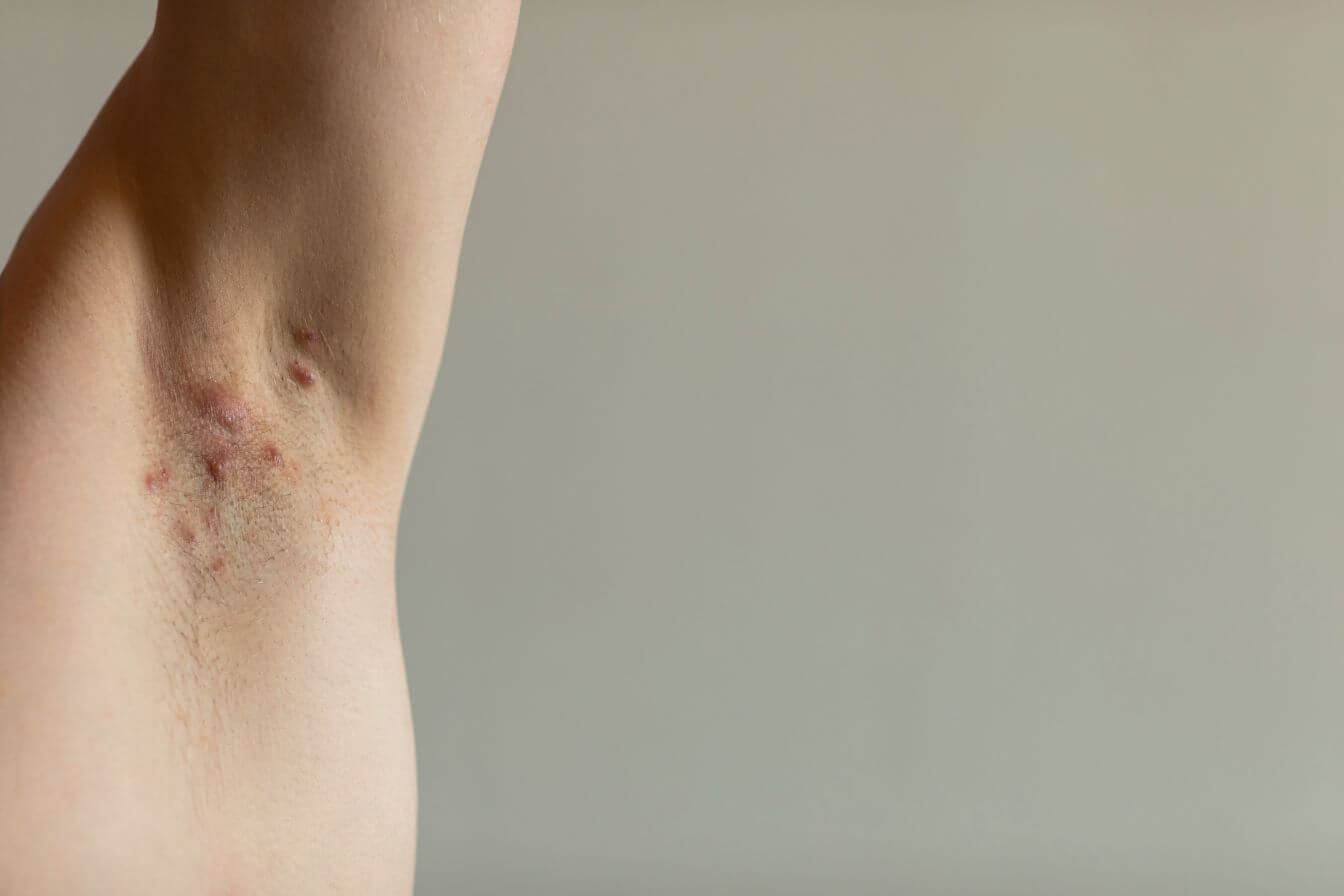Hidradenitis suppurativa is a painful, inflammatory skin condition that can be difficult to treat, and it recurs frequently. This can take a toll on an individual’s physical, mental, and emotional well-being. According to Dr. Adam Luber of U.S. Dermatology Partners in Phoenix and Scottsdale, Arizona, “Managing hidradenitis suppurativa can be a diagnostic and therapeutic challenge for patients and dermatologists. It can be undiagnosed for years, leading to unnecessary suffering.” In this blog, Dr. Luber walks through what hidradenitis suppurativa is, what causes it, and how it’s treated.
What is Hidradenitis Suppurativa?
Hidradenitis Suppurativa (HS) is a chronic skin condition that often goes misunderstood and misdiagnosed. This painful and debilitating disease affects the apocrine sweat glands, leading to the development of painful nodules, abscesses, and tunnels beneath the skin. This condition typically develops where apocrine glands are located, such as the armpits, groin, buttocks, and under the breasts of women. According to Dr. Luber, “HS is an uncommon, but not rare, disease. A 2017 estimate published in the Journal of the American Medical Association Dermatology indicated a prevalence of 1 in 1000 people developing HS. While any patients may develop HS, this study indicated that those between the ages of 30 and 39 and women were significantly more likely to develop this condition.”
Symptoms of HS
Because it is a relatively rare condition, Dr. Luber says, “HS can be mistaken for many other skin conditions including acne, folliculitis, or infections. Early recognition of the disease and expeditious intervention are crucial for managing the symptoms and improving the quality of life for affected patients.”
Some of the most common symptoms of HS include:
- Chronic blackheads in areas of the skin like the armpits, buttocks, groin, and beneath the breasts.
- Painful lesions on the skin lasting weeks or months.
- Development of draining tunnels beneath the skin.
- Lesions may grow large and burst, emitting foul-smelling pus or blood.
Potential Causes and Triggers
Currently, there is no known specific cause of HS. There is some indication that certain inherited genes predispose people to develop this condition. However, not all people with the associated gene develop HS. Researchers theorize that HS may be linked to a group of genes, or it may require a trigger to activate the gene, leading to the inflammatory response that underlies HS. While the root cause is still unknown, many factors increase the risk for HS and may contribute to or trigger a flare in this skin condition, including:
- Genetics – Those with one or more family members who have HS are more likely to develop this condition.
- Age – HS develops during or after puberty with the highest concentration of cases developing in the 30s. For many, the condition is first diagnosed in adulthood because the severity has increased over time.
- Gender – Research indicates that women are more likely to develop HS than men, and this may be linked to a difference in the production of certain hormones as well as a potentially greater likelihood that women will inherit genes related to HS.
- Weight – Increased body mass is associated with an increased risk of developing HS.
- Tobacco use – Nicotine is a contributor to the blockage of hair follicles, which can directly trigger an HS flare.
- Other medical conditions – Increased risk for developing HS and having more severe flares has been linked to numerous medical conditions, including thyroid disease, diabetes, arthritis, psoriasis, vitiligo, inflammatory bowel disease, polycystic ovary syndrome, and squamous cell carcinoma.
Diagnosis and Assessment
In most cases, diagnosis of HS is completed through visual and manual inspection of the affected area. In some cases, a biopsy may be performed where a portion of the lump may be removed and viewed under a microscope to rule out other skin conditions. A dermatologist may also opt to test fluid from the lesions or perform blood tests. These types of tests are typically done to rule out other conditions and ensure an accurate diagnosis before planning treatment.
Current Treatment Options
According to Dr. Luber, “HS is a difficult skin condition to manage. It requires a strong effort from the patient, including a consistent skincare regimen, long-term pharmacologic treatment plan, and partnership with a dermatologist and often other medical professionals. Specific treatment options may include topical and systemic medications, lifestyle modifications, and in severe cases, surgical interventions. Tailoring the treatment plan to the individual patient is essential for achieving the best outcomes. Your dermatologist and other healthcare providers will work with you to develop a comprehensive treatment plan.”
Some of the most often recommended HS treatment options include:
- Oral and/or topical antibiotics to prevent or treat infection.
- Injected steroids to directly address skin inflammation in specific areas where flares occur.
- Pain relievers to reduce the discomfort.
- Retinoids may be used to treat or quickly heal skin during a flare.
- Anti-hormonal agents may be prescribed to reduce the frequency and severity of HS.
- Biologics are prescribed to control the immune system’s behavior.
- Surgery to remove affected areas of skin.
- Laser treatments may be used to remove hair from follicles in affected areas.
Living with Hidradenitis Suppurativa
HS doesn’t just impact a person’s skin health. It is a chronic, inflammatory disease, meaning there is also pain associated with flare-ups in this condition. The appearance of HS flare-ups can also cause people to feel self-conscious. Worrying about HS often leads to increased anxiety or stress levels. Managing HS is about addressing all the effects of this condition, physical and emotional. According to Dr. Luber, “The emotional toll of HS is significant. Dermatologists acknowledge the psychological impact, collaborating with mental health professionals to address anxiety, depression, and the social challenges that often accompany this condition. Building a strong support system is crucial for individuals navigating the emotional landscape of Hidradenitis Suppurativa. HS foundation has amazing resources and support groups for our patients: www.hs-foundation.org/support-groups.”
A Team Approach for Healthier Skin
Managing HS is a lifelong process. Dr. Luber says, “Hidradenitis Suppurativa is a complex and challenging condition that requires a multidisciplinary approach for effective management. Dermatologists have expert knowledge of this condition and play a pivotal role in helping patients navigate the physical and emotional aspects of this disease. As awareness grows and research advances, there is hope for improved treatments and, ultimately, a better quality of life for those living with Hidradenitis Suppurativa.”
Partner with an Expert for Healthier Skin
Whether you or a loved one notices signs of HS, don’t hesitate to reach out to a dermatologist. Without proper treatment and ongoing support, this condition can be very painful. It’s always best to begin managing the symptoms as soon as possible. If you’re interested in working with one of the trusted U.S. Dermatology Partners teams, we make getting started easy. Simply take a few moments to complete the online scheduling request form. Once we hear from you, a dermatology team member will be in touch to finalize the details of your visit.
Find a location near me
or


